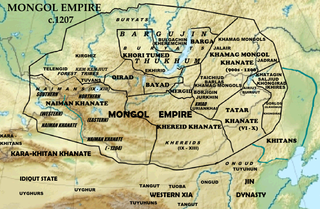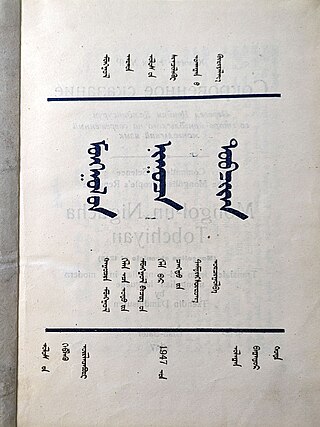Articles related to Mongolia include:
Ragibagh, also known by his era name as the Tianshun Emperor of Yuan, was a son of Yesün Temür who was briefly installed to the throne of the Yuan dynasty of China in Shangdu in 1328. Although he should have been the seventh ruler of the Yuan dynasty in succession to his father Yesün Temür, he was dethroned by his rival Tugh Temür who was installed by a coup before Ragibagh's succession. Apart from Emperor of China, he is regarded as the 11th Great Khan of the Mongol Empire, although it was only nominal due to the division of the empire. He was the shortest-reigning Yuan emperor.

A Borjigin is a member of the Mongol sub-clan that started with Bodonchar Munkhag of the Kiyat clan. Yesugei's descendants were thus said to be Kiyat-Borjigin. The senior Borjigids provided ruling princes for Mongolia and Inner Mongolia until the 20th century. The clan formed the ruling class among the Mongols and some other peoples of Central Asia and Eastern Europe. Today, the Borjigid are found in most of Mongolia, Inner Mongolia and Xinjiang, and genetic research has shown that descent from Genghis Khan and Timur is common throughout Central Asia and other regions.

The Merkit was one of the five major tribal confederations (khanlig) of probably Mongol or Turkic origin in the 12th century Mongolian Plateau.

The Secret History of the Mongols is the oldest surviving literary work in a Mongolian language. Written for the Mongol royal family some time after the death of Genghis Khan in 1227, it recounts his life and conquests, and partially, the reign of his successor Ögedei Khan.

Hö'elün was a Mongolian noblewoman and the mother of Temüjin, better known as Genghis Khan. She played a major role in his rise to power, as described in The Secret History of the Mongols.
The Altan Tobchi, or Golden Summary, is a 17th-century Mongolian chronicle written by Guush Luvsandanzan. Its full title is Herein is contained the Golden Summary of the Principles of Statecraft as established by the Ancient Khans. The work is also named the Lu Altan Tobchi after its author to distinguish it from previous works with similar titles.
The Erdeniin Tobchi is a national chronicle of the Mongols written by Saghang Sechen in 1662.
Qasar was one of Genghis Khan's three full brothers. According to the Jami' al-Tawarikh, his given name was Jo'chi and he got the nickname Khasar after his distinguished bravery. He was also called Habutu Hasar because he was skilled with a bow.

Tengrism is a religion originating in the Eurasian steppes, based on shamanism and animism. It generally involves the titular sky god Tengri, who is not considered a deity in the usual sense but a personification of the universe. According to some scholars, adherents of Tengrism view the purpose of life to be in harmony with the universe.

The location of the burial place of Genghis Khan has been the subject of much speculation and research. The site remains undiscovered, although it is generally believed that it is near the Mongol sacred mountain of Burkhan Khaldun in the Khentii Mountains.
Nigülesügchi Khan, born Elbeg, (1362–1399) was a khagan of the Northern Yuan dynasty, reigning from 1394 to 1399. Erdeniin Tobchi claimed that Elbeg was the younger brother of the Jorightu Khan, while other historians testify that he was a son of the Biligtü Khan. He ruled for seven years. His regnal title "Nigülesügchi Khagan" means "Merciful Emperor" in the Mongolian language. Border skirmishes with the Ming dynasty and Oirat rebellion plagued his reign.
Gün Temür, regnal name Toqoqan Khan, (1377–1402) was a khagan of the Northern Yuan dynasty, reigning from 1399 to 1402. Erdeniin Tobchi claimed that Gün Temür was the eldest son of Elbeg Nigülesügchi Khan, but records in Habib al-siyar and Zafarnama he as other Genghizid. His name, Gün Temür, means "Deep (intellectually) Iron" in the Mongolian language.
Delbeg, (1395–1415) was a khagan of the Northern Yuan dynasty, reigning from 1412 to 1415. Delbeg was installed by the Oirats in 1411 as a puppet ruler, but this was not recognized by most of Mongol clans in the central and eastern Mongol territories.
The Four Oirat ; also Oirads and formerly Eleuths, alternatively known as the Alliance of the Four Oirat Tribes or the Oirat Confederation, was the confederation of the Oirat tribes which marked the rise of the Western Mongols in the history of the Mongolian Plateau.
Various nomadic empires, including the Xiongnu, the Xianbei state, the Rouran Khaganate (330–555), the First (552–603) and Second Turkic Khaganates (682–744) and others, ruled the area of present-day Mongolia. The Khitan people, who used a para-Mongolic language, founded an empire known as the Liao dynasty (916–1125), and ruled Mongolia and portions of North China, northern Korea, and the present-day Russian Far East.

Mongolian literature is literature written in Mongolia and/or in the Mongolian language. It was greatly influenced by and evolved from its nomadic oral storytelling traditions, and it originated in the 13th century. The "three peaks" of Mongol literature, The Secret History of the Mongols, Epic of King Gesar and Epic of Jangar, all reflect the age-long tradition of heroic epics on the Eurasian Steppe. Mongol literature has also been a reflection of the society of the given time, its level of political, economic and social development as well as leading intellectual trends.
Bodonchar Munkhag was a renowned Mongol Borjigin tribal chieftain and warlord. He was a direct ancestor of Genghis Khan who was the founder of Mongol Empire in 1206, as well as the Mongol Barlas tribe of the Central Asian conquerer Amir Timur who was the founder of Timurid Empire in 1370.
Saghang Sechen was an ethnic Mongol writer, historian and prince from the Borjigin clan.
The Shengwu qizheng lu is a Chinese translation of a Mongolian chronicle describing the lives of Genghis Khan and his son Ögedei Khan. Much of the chronicle was derived from the Altan Debter, a now-lost state history of the Mongol Empire. Both the Persian Jami' al-tawarikh, written by Rashid al-Din at the start of the 14th century, and the Chinese Yuán Shǐ, drew upon the Altan Debter. By combining the three extant works, historians are able to adequately reconstruct the Altan Debter's original content.






